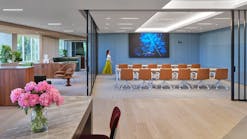Sales and profits down at ams Osram. Can micro LEDs help reverse things?
A second major LED outfit reported a decline for the fourth quarter ending Dec. 31, as ams Osram said revenue dropped 4% while adjusted income plunged 75%. Like Signify, it did not see immediate improvement. It noted that difficulties continue in many sectors including horticulture.
The Premstaetten, Austria–based company, which will soon have a new CEO and CFO to steer its recovery, sells a wide range of optical chips, including LEDs as well as lasers, sensors, and photonic components. Its results are thus not a strict reflection of the LED market.
But the company counted LEDs among the trouble spots in noting that fourth-quarter revenue slid to €1.18 billion ($1.27 billion) from €1.23 billion ($1.32 billion) in the same quarter a year ago. Some of the decline represented revenue that no longer comes in from former Osram divisions which ams Osram has sold, such as Clay Paky, Traxon Technologies, and many others.
The quarter’s adjusted “net result” — income — tumbled to €29 million ($31.1 million) from €119 million ($127.6 million) last year. The “adjustments” exclude costs related to, among others: mergers and acquisitions; certain transformation costs for the continuing integration of Osram following ams’ long and involved acquisition of the company; investments in “associates”; and the sale of business, the company explained in a footnote to its published results.
Taking those costs into account, ams Osram lost €147 million ($157.6 million) in the quarter, compared to a profit of €168 million ($180 million) one year ago
For the full year 2022, revenue fell 4.3% to €4.82 billion ($5.17 billion) from €5.04 billion ($5.4 billion), while adjusted income fell 19% to €407 million ($436.4 million) from €502 million ($538.3 million) in 2021. The non-adjusted loss plummeted to €444 million ($476 million) from a smaller 2021 full-year loss of €32 million ($34.3 million).
'Difficult ... macroeconomic environment' cited
Outgoing CEO Alexander Everke lauded the company’s ability to make the most out of a difficult global environment that includes the war in Ukraine, China’s COVID surge, inflation, and other macroeconomic afflictions, as well as troubled automotive and consumer sectors. The Asia Pacific region, including China, is a key market for ams Osram. China represented 52% of its revenues over the year.
“Our business delivered full-year and fourth-quarter results that reflect a solid overall performance of our business in an increasingly difficult sector and macroeconomic environment over the course of the second half,” Everke noted.
But he was wary of committing to a near-term improvement for 2023. Things could start to turn around in the second half, he said.
His caution echoed an outlook by Signify CEO Eric Rondolat, who declined to give a 2023 sales forecast when he delivered Signify 2022 results recently. Everke was not quite as noncommittal. He forecast first-quarter sales of between €900 million ($965 million) and €1 billion ($1.1 billion), a level the company described as “muted.”
Everke also made it clear that the LED chip business — the raison d’être of ams’ acquisition of Osram — has been among the slowing operations. While LEDs fared well in “industrial solutions,” that was not the case in other areas.
“In the fourth quarter, increasingly negative demand effects driven by the macroeconomic environment and regional dynamics in China impacted the segment’s industrial business in certain areas including LED industrial and outdoor lighting and horticulture solutions,” he said.
The fourth quarter marked the second consecutive quarter in which ams Osram has reported stalling in horticulture, which had emerged as a bright spot for the industry. Two quarters ago, Signify also noted a wobbly round for horticulture. Signify did not provide a horticultural update in its late January fourth-quarter report. LEDs Magazine has requested one.
A strong push for micro LEDs
It will soon be the job of incoming CEO Aldo Kamper to put things right as best as possible at ams Osram, which today revealed that he will start on April 1. It previously described his start date only generally as in the spring.
Much of the long-term hope resides in the LEDs and micro LEDs that ams Osram plans to start making at its Kulim, Malaysia factory beginning in 2024. The company is in the midst of a nearly $1 billion expansion of the site where it is building a new plant that will produce devices from 8-inch wafers, rather than the current 6-inch wafer.
Ams Osram expects the new approach to provide it with a competitive advantage. The larger wafers can be more economical because they yield more chips.
On a web call with analysts today, Everke repeatedly hailed what he called ams Osram’s clear leadership position in 8-inch–based micro LEDs, both in intellectual property and in manufacturing of the devices that will be key in wearables, AR/VR, and other areas.
He said the 8-inch factory will ramp up in 2024, and that the company will start reporting significant sales of micro LEDs made there in 2025.
No sooner did he express confidence in the 8-inch future than analysts flooded him with questions. They wondered, among other things, whether the timetable was slipping, whether profits would be hard to come by amid high costs, whether the technology still holds significant engineering hurdles, and whether ams Osram was in jeopardy of losing its stated competitive advantage as other manufacturers start to fire up 8-inch fabrication plants.
Everke and Bank insisted that the ramp-up was on schedule both for the plant as a whole and the micro LED portion of it. They declined to elaborate on the state of a prepayment that one customer has agreed to make for product from the 8-inch facility.
LEDs will break out Everke’s and Bank’s discussion of the new factory and micro LEDs in a separate article.
Not all LED and lighting companies are in a downturn. Norway’s Glamox, for instance, recently reports an increase in fourth-quarter sales and profits, in part on the strength of its offshore wind and maritime sector.
Exchange rates current at time of writing, via xe.com.
MARK HALPER is a contributing editor for LEDs Magazine, and an energy, technology, and business journalist ([email protected]).
For up-to-the-minute LED and SSL updates, follow us on Twitter. You’ll find curated content and commentary, as well as information on industry events, webcasts, and surveys on our LinkedIn page and our Facebook page.

Mark Halper | Contributing Editor, LEDs Magazine, and Business/Energy/Technology Journalist
Mark Halper is a freelance business, technology, and science journalist who covers everything from media moguls to subatomic particles. Halper has written from locations around the world for TIME Magazine, Fortune, Forbes, the New York Times, the Financial Times, the Guardian, CBS, Wired, and many others. A US citizen living in Britain, he cut his journalism teeth cutting and pasting copy for an English-language daily newspaper in Mexico City. Halper has a BA in history from Cornell University.






